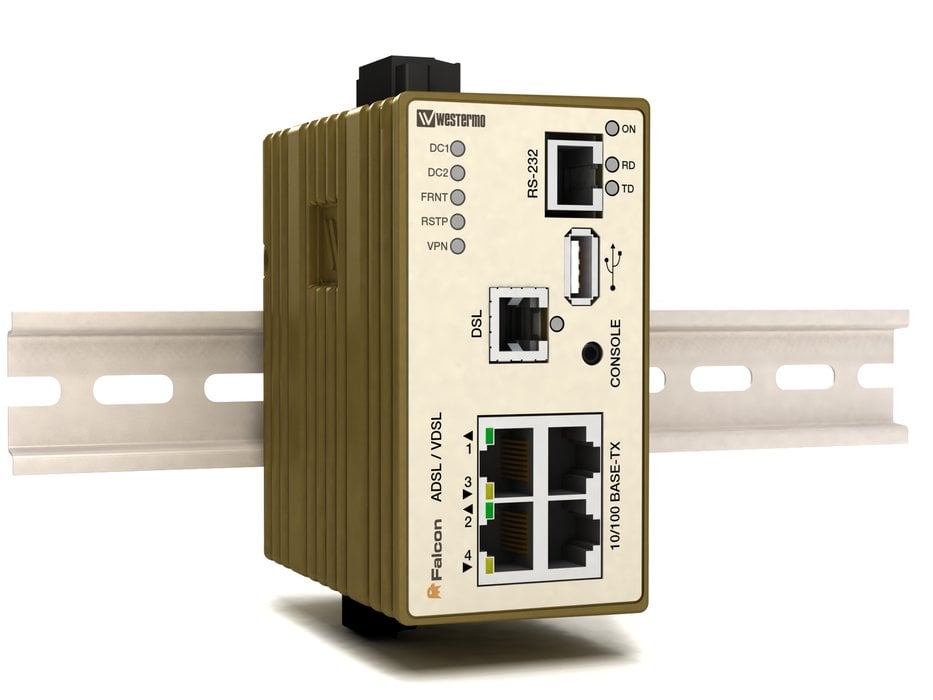www.magazine-industry-usa.com
29
'10
Written on Modified on
Falcon: the world’s first VDSL2 router for industrial applications
The new Falcon industrial broadband router with integrated Ethernet routing switch is designed to provide two-way high-speed secure communication between remote sites enabling economical and reliable connection to equipment such as SCADA, PLCs, RTUs and I/O devices.

The Falcon is based on the new VDSL2 (Very-high-speed Digital Subscriber Line 2) standard, the latest and most advanced version of DSL broadband communications. Already well established in many parts of the world, VDSL2 meets the increased bandwidth requirements of both commercial and industrial users. Upstream and downstream data-rates of 100 Mbit/s are possible depending on service provider bandwidth control.
Current offered services features upstream speeds of up to 40 times higher than ADSL technology, making VDSL2 ideal for the industrial remote access market that often requires a higher uplink. This improved performance is particularly significant for applications requiring live video images to be sent from remote locations, which require high bandwidths.
The Falcon has an extremely compact industrial design, with a purpose built rugged metal housing that incorporates a vibration proof integrated DIN rail clip. The device is capable of operating in temperatures from -20 to +60C and with high EMC levels found in some industrial applications. High MTBF (mean time between failures) figures lead to an expected service life of at least 10 years. When used in critical applications the Falcon can be powered from separate DC voltage sources with inputs ranging from 16-60VDC.
In order to enable Ethernet communications, common in the latest industrial I/O devices, the Falcon features an integrated 4 port Layer 3 routing switch. In addition, an RS232 port and the built in device server interface can be used to connect legacy serial devices. This enables a migration path from older legacy systems to new IP based solutions without the need to replace the equipment. ADSL will remain in use for many years alongside the newer VDSL2 services. The Falcon has therefore been designed to support ADSL, ADSL 2 and ADSL2+ broadband technologies.
With connections being made via the internet, security is critical. The Falcon has a built-in stateful packet inspection firewall and can support IPsec VPN (Virtual Private Networks) tunnels, secured by encryption protocols.
Network Address Translation (NAT), port forwarding and SNMP V3 (Simple Network Management Protocol) provides additional security features. Also Layer 3 VLAN functionality means the integrated switch can be configured to filter certain traffic types and enables simple DMZ firewall (demilitarised perimeter network) configurations to be constructed for securing LANs.
The Falcon can be configured in a number of ways including a secure, easy-to-use web interface and a professional command line interface (CLI) that can be accessed locally, via a console interface, or via a secure IP connection (SSH). Once the device is operational, its management and diagnostics can be handled using SNMP, SysLog or via user configurable fault contacts.
When using broadband networks from internet service providers, connection is made through a DSLAM (Digital Subscriber Line Access Multiplexer) device. To maximise the interoperability between devices, the University of New Hampshire Interoperability Laboratory (UNH-IOL) hosts a large-scale, heterogeneous test bed of DSL equipment to assist its members in developing proven, interoperable products. Westermo is the first industrial member of the UNH-IOL's DSL Consortium.
Current offered services features upstream speeds of up to 40 times higher than ADSL technology, making VDSL2 ideal for the industrial remote access market that often requires a higher uplink. This improved performance is particularly significant for applications requiring live video images to be sent from remote locations, which require high bandwidths.
The Falcon has an extremely compact industrial design, with a purpose built rugged metal housing that incorporates a vibration proof integrated DIN rail clip. The device is capable of operating in temperatures from -20 to +60C and with high EMC levels found in some industrial applications. High MTBF (mean time between failures) figures lead to an expected service life of at least 10 years. When used in critical applications the Falcon can be powered from separate DC voltage sources with inputs ranging from 16-60VDC.
In order to enable Ethernet communications, common in the latest industrial I/O devices, the Falcon features an integrated 4 port Layer 3 routing switch. In addition, an RS232 port and the built in device server interface can be used to connect legacy serial devices. This enables a migration path from older legacy systems to new IP based solutions without the need to replace the equipment. ADSL will remain in use for many years alongside the newer VDSL2 services. The Falcon has therefore been designed to support ADSL, ADSL 2 and ADSL2+ broadband technologies.
With connections being made via the internet, security is critical. The Falcon has a built-in stateful packet inspection firewall and can support IPsec VPN (Virtual Private Networks) tunnels, secured by encryption protocols.
Network Address Translation (NAT), port forwarding and SNMP V3 (Simple Network Management Protocol) provides additional security features. Also Layer 3 VLAN functionality means the integrated switch can be configured to filter certain traffic types and enables simple DMZ firewall (demilitarised perimeter network) configurations to be constructed for securing LANs.
The Falcon can be configured in a number of ways including a secure, easy-to-use web interface and a professional command line interface (CLI) that can be accessed locally, via a console interface, or via a secure IP connection (SSH). Once the device is operational, its management and diagnostics can be handled using SNMP, SysLog or via user configurable fault contacts.
When using broadband networks from internet service providers, connection is made through a DSLAM (Digital Subscriber Line Access Multiplexer) device. To maximise the interoperability between devices, the University of New Hampshire Interoperability Laboratory (UNH-IOL) hosts a large-scale, heterogeneous test bed of DSL equipment to assist its members in developing proven, interoperable products. Westermo is the first industrial member of the UNH-IOL's DSL Consortium.

